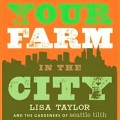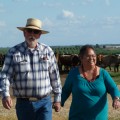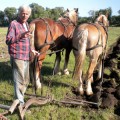I spent the past two weeks shooting the pilot episode of a PBS documentary series I co-created called Food Forward (www.foodforward.tv). The episode is on urban agriculture and we shot on location in New York City, Detroit, Cleveland, Milwaukee and west Oakland.
Before I left, I was intrigued by the number of urban farms sprouting across the country, but I was skeptical. I’m all for small-scale agriculture, but what difference were these city farms making? A few people were getting some fresh lettuce and tomatoes and learning how to grow their own food, but was that it? Industrial food production is a disaster, but given the power and reach of the factory food machine, what change can cute, plucky little urban ag bring about?
The short answer: a big difference. At Milwaukee’s Sweet Water Organics, I saw a former factory turned into an aquaponics farm, a fish-and-vegetable operation in which the plants and fish work in a closed-loop system to produce food year-round and employ 40 people. I spoke with Columbia University public health professor Dickson Despommier, a dreamer who designs vertical farms that he says will allow farmland to revert to its natural state and bring large-scale food production and jobs into cities.
I rode the elevator to the top of a six-story building in Queens where Ben Flanner and crew have created a 1-acre rooftop farm, Brooklyn Grange. The farm not only grows delicious tomatoes with great views of Manhattan, it’s opening people’s minds to alternative methods of food production.
And I watched 61-year-old Edith Floyd drive down her street in east Detroit in a bright orange Kubota tractor where she farms 14 lots. The lots were once homes, but the city’s cratering economy forced half the city’s population to move. Abandoned homes are everywhere now and many are caving in on themselves or have burned to the ground. But Floyd has turned the devastation into opportunity. The urbanite-turned-farmer feeds herself and sells the excess at the city’s Eastern Market.
Add it all up and you see the creation of a post-industrial food system that better serves local communities, treads more lightly on the earth, beautifies cities and creates economic alternatives to Big Ag. It’s transformational. Urban agriculture won’t feed the world or even the cities where it’s flourishing. But the strength of the movement is its power to transform: individuals, neighborhoods, communities, cities and, maybe one day, nations.
The transformation that’s occurring is from a failed, unsustainable food system to one that better serves the common good. Urban agriculture opens a door to another reality. Pass through this door and you see the world as it really is as well as the possibility for a creating a better one.
The end of industrial food may not be near, but it will come. It’s collapsing under the weight of its inherent instability. The planet will only tolerate so much abuse. Climate change will take care of what’s left. The system will weaken further as more people abandon it in favor of smaller-scale food production that better serves the common good and just plain tastes better. Whether by necessity or choice, urban agriculture is a potent force that’s redefining America’s relationship with the food we eat and with ourselves.

 San Jose’s Art Colony
San Jose’s Art Colony 


